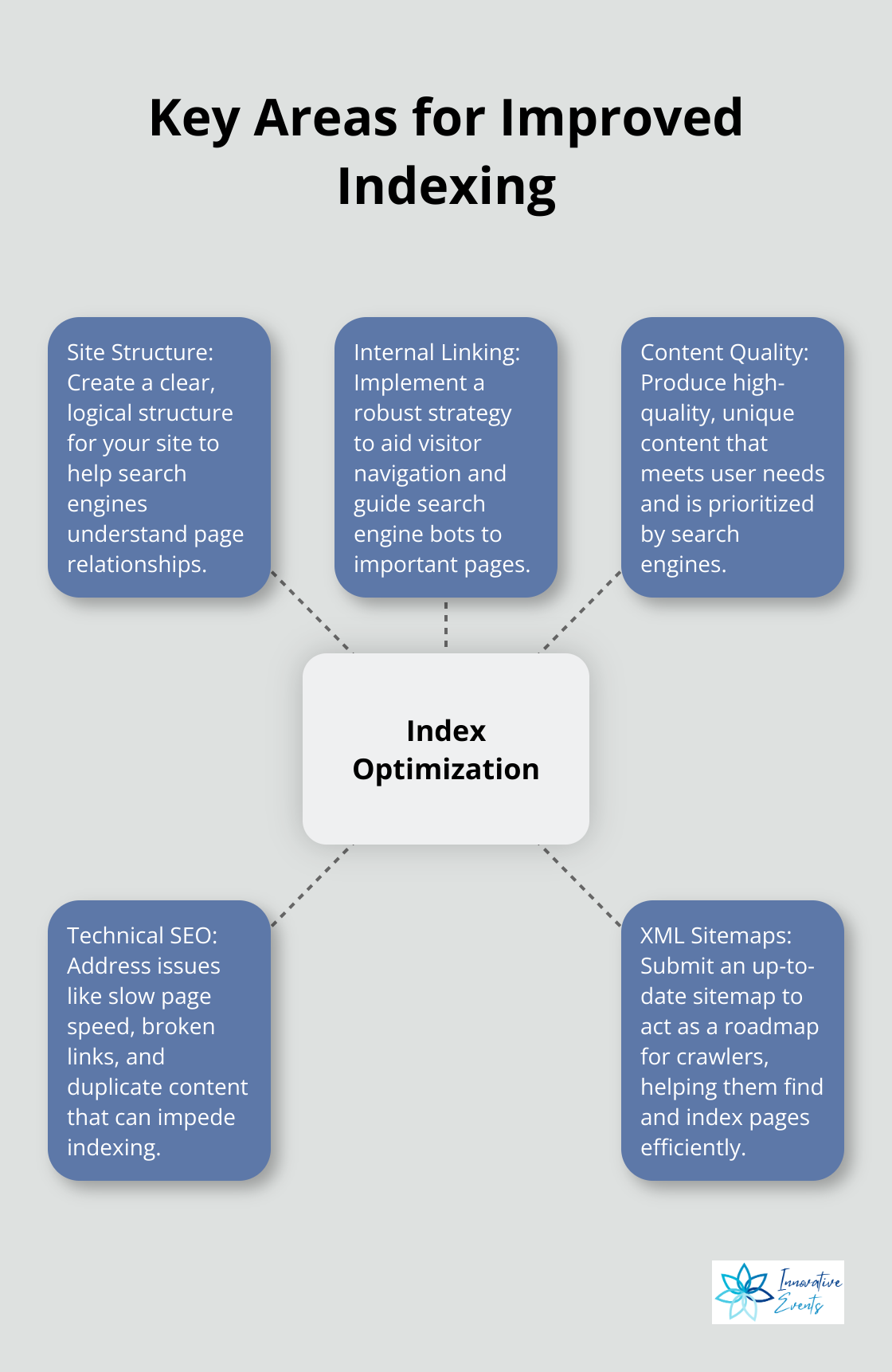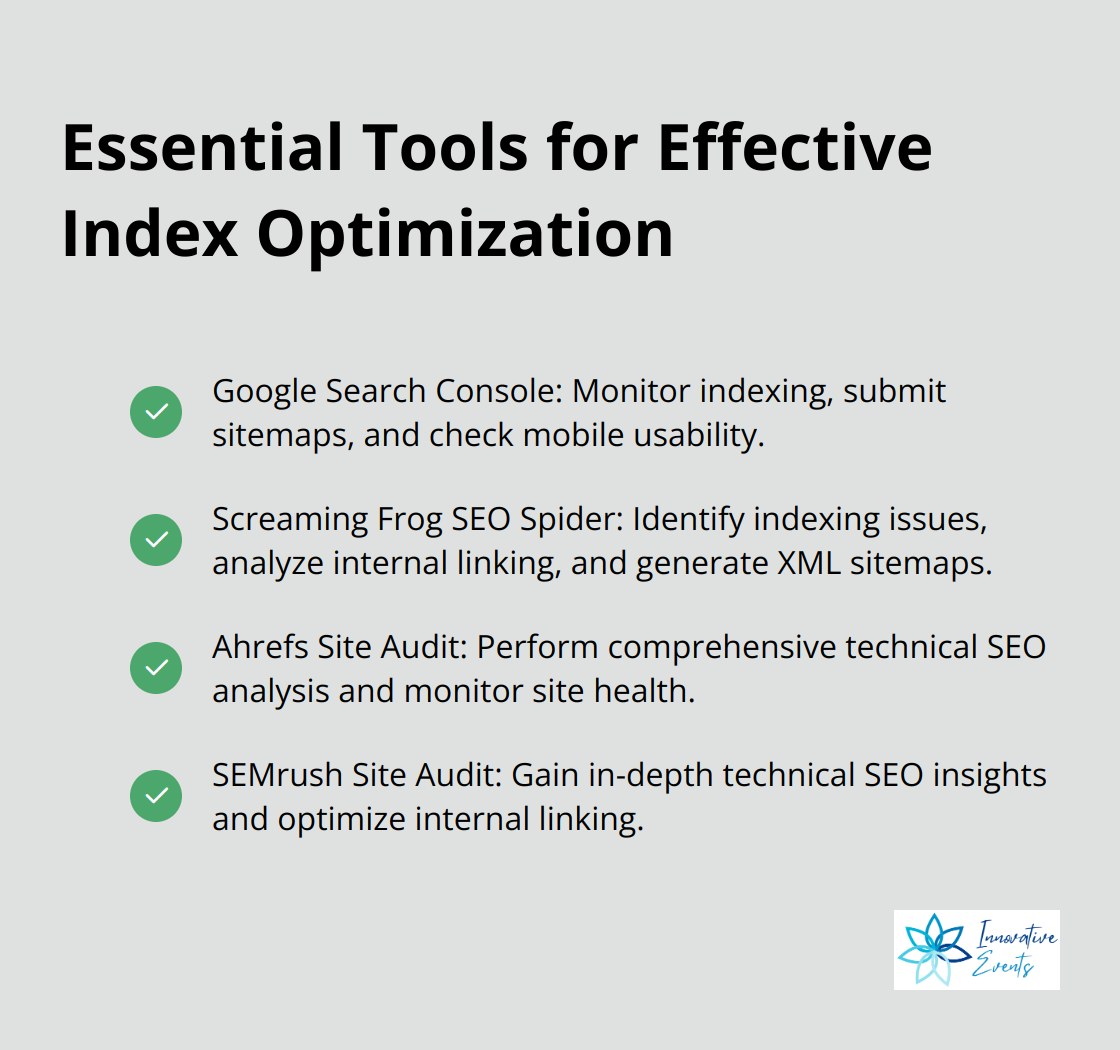At Innovative Events, we know that index optimization is crucial for SEO success.
Index optimization SEO is the process of ensuring search engines can efficiently crawl and index your website’s content. This practice directly impacts your site’s visibility and ranking in search results.
In this post, we’ll explore effective strategies and tools to improve your website’s indexing, boosting your overall SEO performance.
What is Index Optimization?
Definition and Importance
Index optimization is the process of refining your website to enhance its accessibility and comprehensibility for search engine bots. This practice is essential for SEO performance, as it directly influences your site’s visibility and ranking in search results.
A study revealed that many pages receive no organic search traffic from Google (often due to poor indexing). Effective index optimization gives your content the best chance to be discovered and ranked.
The Indexing Process Explained
Search engines employ complex algorithms and bots (also known as spiders or crawlers) to discover, crawl, and index web pages. Here’s a simplified breakdown of the process:
- Discovery: Search engine bots find your pages through links from other sites or your sitemap.
- Crawling: The bots visit your pages and read the content.
- Indexing: The content undergoes analysis and storage in the search engine’s index.
Key Areas for Improved Indexing
To enhance your site’s indexing, focus on these critical aspects:
Site Structure
Create a clear, logical structure for your site. This approach helps search engines understand the relationships between your pages.
Internal Linking
Implement a robust internal linking strategy. This tactic not only aids visitors in navigating your site but also guides search engine bots to your important pages.
Content Quality
Produce high-quality, unique content. Search engines prioritize indexing valuable content that meets user needs (this is particularly important in the current SEO landscape).
Technical SEO
Address technical issues such as slow page speed, broken links, and duplicate content. These problems can impede the indexing process.
XML Sitemaps
Submit an up-to-date XML sitemap to search engines. This tool acts as a roadmap for crawlers, helping them find and index your pages more efficiently.
The next section will explore specific strategies to optimize your website for better indexing, building on these fundamental concepts.

How to Optimize Your Site for Better Indexing
At Innovative Events, we’ve discovered that effective index optimization makes your website easily discoverable and understandable for search engines. Here are key strategies we’ve found particularly effective:
Fine-tune Your Robots.txt File
Your robots.txt file acts as a set of instructions for search engine crawlers. It tells them which parts of your site to index and which to ignore. A well-optimized robots.txt file can significantly improve your site’s crawlability.
To optimize your robots.txt file:
- Allow access to important resources like CSS and JavaScript files (blocking these can prevent search engines from rendering your pages correctly).
- Block access to private or duplicate content.
- Specify the location of your XML sitemap.
Test your robots.txt file using Google Search Console’s robots.txt Tester tool to ensure it works as intended.
Maximize the Power of XML Sitemaps
XML sitemaps help search engines understand your site structure and find all your important pages. They’re especially useful for large websites or those with complex structures.
To make the most of your XML sitemap:
- Include all important URLs, but keep it under 50,000 URLs or 50MB in size.
- Update your sitemap regularly, especially when you add or remove pages.
- Submit your sitemap to search engines through their webmaster tools.
- Use dynamic sitemaps for large sites that change frequently.
Implement Canonical Tags Correctly
Canonical tags are essential for dealing with duplicate content issues. They tell search engines which version of a page should be considered the “master” copy.
To implement canonical tags effectively:
- Use self-referencing canonicals on all pages, even if there’s no duplicate content.
- Place your canonical tags in the <head> section of your HTML.
- Use absolute URLs in your canonical tags.
- Be consistent with your use of www vs. non-www and http vs. https in your canonical URLs.
Build a Strong Internal Linking Structure
A solid internal linking strategy helps users navigate your site and distributes link equity. It also helps search engines understand your site structure.
To improve your internal linking:
- Use descriptive, keyword-rich anchor text for your links.
- Link from high-authority pages to important pages you want to rank.
- Create a logical hierarchy with your site structure and internal links.
- Use breadcrumbs to improve navigation and help search engines understand your site structure.
These strategies can significantly improve your site’s indexability and, consequently, its search engine performance. Index optimization requires ongoing effort and regular audits to maintain optimal indexing. In the next section, we’ll explore powerful tools and techniques to further enhance your index optimization efforts.

Essential Tools for Effective Index Optimization
Google Search Console: Your Primary Defense
Google Search Console provides information on how Google crawls, indexes, and serves websites. This can help website owners to monitor and optimize Search performance.
Key features include:
- Index Coverage Report: This report displays which pages are indexed, excluded, or have errors (your primary resource for detecting indexing problems).
- URL Inspection Tool: Use this to check individual pages’ indexing status and request indexing for new or updated content.
- Sitemaps: Submit and monitor your XML sitemaps directly through GSC (this ensures Google knows about all your important pages).
- Mobile Usability Report: This report helps you identify and fix mobile usability issues that could affect indexing (particularly important with mobile-first indexing).
Screaming Frog SEO Spider: Emulate Search Engine Crawling
Screaming Frog SEO Spider is a powerful desktop program that crawls websites’ links, images, CSS, scripts, and apps from an SEO perspective. You can now analyse the semantic similarity of pages in a crawl to help detect duplicate, similar, and potentially off-topic, less relevant content on a site.
Use it for index optimization by:
- Identifying Indexing Issues: Screaming Frog finds pages with noindex tags, redirect chains, and other technical SEO issues that could hinder indexing.
- Analyzing Internal Linking: The tool provides a clear picture of your site’s internal link structure, helping you optimize it for better crawling and indexing.
- Generating XML Sitemaps: Automatically create XML sitemaps based on your crawl data (this ensures all important pages are included).
Ahrefs Site Audit: Comprehensive Technical SEO Analysis
Ahrefs Site Audit tool offers a thorough analysis of your website’s health, including indexability issues. It excels in ongoing monitoring and improvement.
Key features for index optimization:
- Crawl Report: This provides an overview of indexable and non-indexable pages, helping you spot potential issues.
- Internal Link Structure: Ahrefs provides detailed insights into your site’s internal linking (critical for optimizing crawl paths).
- Content Quality Check: The tool identifies thin content, which can negatively impact indexing and rankings.
SEMrush Site Audit: In-Depth Technical SEO Insights
SEMrush’s Site Audit tool is another comprehensive option for technical SEO analysis, with several features specifically useful for index optimization.
Standout features include:
- Crawlability and Site Architecture: SEMrush provides a clear overview of your site’s structure and any issues that might impede crawling.
- Internal Linking Report: This detailed report helps you optimize your internal link structure for better indexing.
- HTTPS Implementation: This feature ensures your HTTPS implementation is correct and won’t cause indexing issues (secure sites are a ranking factor).
Each of these tools offers unique strengths for index optimization. Many SEO professionals use a combination of these tools to get a comprehensive view of websites and identify all potential indexing issues. The key to effective index optimization lies in acting on the insights these tools provide.

Final Thoughts
Index optimization SEO forms the foundation of effective digital marketing. It improves visibility, boosts rankings, and drives organic traffic to your website. Regular audits of site structure, content quality, and technical SEO elements maintain optimal indexing (this process should be ongoing, not a one-time task).
AI and machine learning will likely play a larger role in how search engines crawl and index content in the future. This shift will emphasize the importance of high-quality, relevant content even more. We expect to see more sophisticated tools for real-time indexing and faster content discovery.
At Innovative Events, we understand the critical role of SEO in driving business success. We help optimize your digital presence for peak performance, just as we assist executives with our Ascent Concierge Health program. Focus on index optimization SEO to maximize your online visibility and achieve your business goals.

